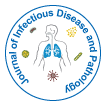开放获取期刊获得更多读者和引用
700 种期刊 和 15,000,000 名读者 每份期刊 获得 25,000 多名读者
抽象的
Tracking the Origin of a Rabbit Haemorrhagic Virus 2 Outbreak in a Wild Rabbit Breeding Centre in Portugal; Epidemiological and Genetic Investigation
Carina Luísa Carvalho, Joana Rodeia, Sandra Branco, Madalena Monteiro, Elsa Leclerc Duarte, Pedro Melo Patrícia Tavares Santos, Ana Margarida Henriques, Sílvia Santos Barros, Fernanda Ramos, Teresa Fagulha, Miguel Fevereiro, Margarida Dias Duarte*
As key prey, the wild rabbit downsize constitutes a major drawback on the endangered Iberian lynx (Lynx pardinus) re-introduction in the Iberia. Several captive breeding units mostly located in Alentejo, endeavour the wild rabbit repopulation of depleted areas assigned for the lynx re-introduction.
Here we report an RHDV2 outbreak that occurred in early 2016 in a wild rabbit captive breeding unit located in Barrancos municipality. The estimated mortality rate between March and April 2016 was approximately 8.67%. Anatomopathologic examination was carried out for 13 victimized rabbits. Molecular characterization was based on the complete vp60 capsid gene.
The 13 rabbit carcasses investigated showed typical macroscopic RHD lesions testing positive to RHDV2- RNA. Comparison of the vp60 nucleotide sequences obtained from two specimens with others publically available disclosed similarities below 98.22% with RHDV2 strains originated in the Iberia and Azores and revealed that the two identical strains from Barrancos-2016 contain six unique single synonymous nucleotide polymorphisms.
In the phylogenetic analysis performed, the Barrancos-2016 strains clustered apart from other known strains, meaning they may represent new evolutionary RHDV2 lineages. No clear epidemiological link could be traced for this outbreak where the mortalities were lower compared with previous years. Yet, network analysis suggested a possible connection between the missing intermediates from which the strains from Barrancos 2013, 2014 and 2016 have derived. It is therefore possible that RHDV2 has circulated endemically in the region since 2012, with periodic epizootic occurrences.
Still, six years after its emergence in wild rabbits, RHDV2 continues to pose difficulties to the establishment of natural wild rabbit populations that are crucial for the self-sustainability of the local ecosystems.

 English
English  Spanish
Spanish  Russian
Russian  German
German  French
French  Japanese
Japanese  Portuguese
Portuguese  Hindi
Hindi